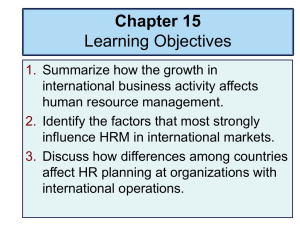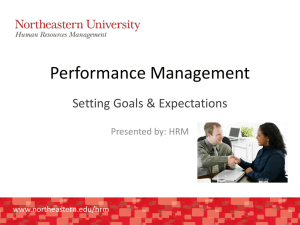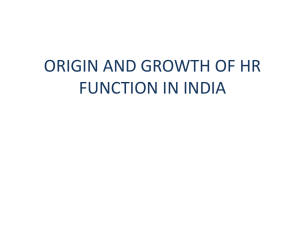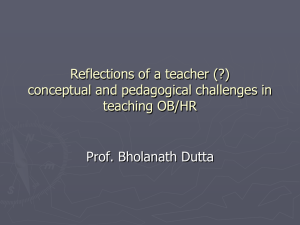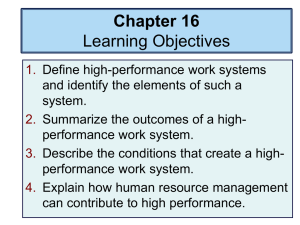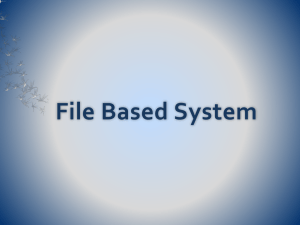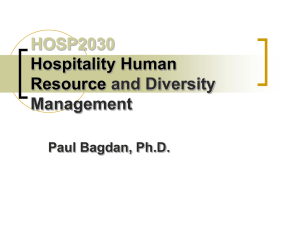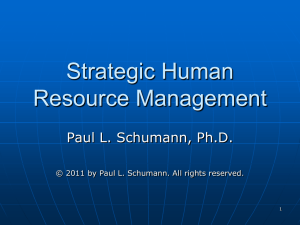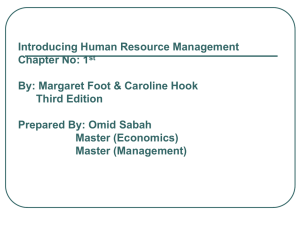ch01
advertisement
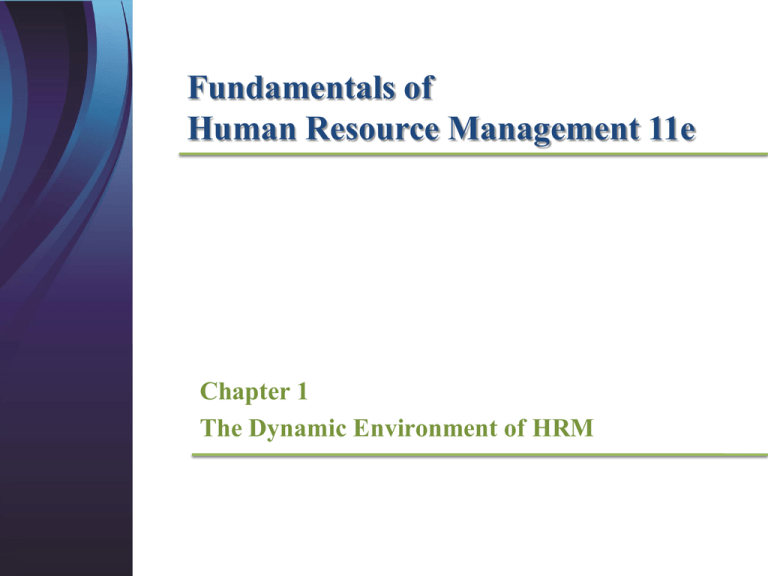
Fundamentals of Human Resource Management 11e Chapter 1 The Dynamic Environment of HRM Introduction HRM is a subset of management. It has five main goals: attract employees retain employees Goals of HRM hire employees motivate train employees employees Strong employees = competitive advantage. Understanding Cultural Environments HRM operates in a global business environment Countries have different • values • morals • customs • political, economic, and legal systems HRM helps employees understand other countries’ political and economic conditions. Exhibit 1-1: Cultural Values Understanding Cultural Environments The Heritage Foundation’s Index of Economic Freedom rates 179 countries on openness to trade, business, investment, and property rights. The U.S. was #10 in 2012. North Korea is the most repressed. TOP 10 FREE COUNTRIES 1. Hong Kong 2. Singapore 3. Australia 4. New Zealand 5. Switzerland 6. Canada 7. Chile 8. Mauritius 9. Ireland 10. United States TOP 10 LEAST-FREE COUNTRIES 1. North Korea 2. Zimbabwe 3. Cuba 4. Libya 5. Eritrea 6. Venezuela 7. Burma 8. Dem. Rep. of Congo 9. Iran 10. Equatorial Guinea 2012 Country Rankings, see www.heritage.org/index/Ranking.aspx The Changing World of Technology HRM operates in a technologically changing environment Thomas Friedman: Globalization 1.0 (1492-1800) Driven by transportation Globalization 2.0 (1800 -2000) Driven by communication Globalization 3.0 (2000 -????) Driven by technology 3.0 fueled by instant communication and the Internet. The Impact of Technology HR is increasingly using IT Knowledge workers focus on the acquisition and application of information for decision making. Some books for aspiring knowledge workers: 1. Learning as a Way of Being by Peter B. Vaill 2. Thinking for a Living: How to Get Better Performance and Results from Knowledge Workers by Thomas H. Davenport 3. Information Anxiety 2 by Richard S. Wurman The Impact of Technology HRM information systems help to • facilitate HR plans • make decisions faster • clearly define jobs • evaluate performance • provide desirable, cost-effective benefits The Impact of Technology • • • • • HR managers use technology to: recruit, hire, and train employees motivate and monitor workers research fair compensation packages communicate throughout the organization evaluate decentralized employees’ performance Workforce Diversity HRM has moved from the melting pot assumption to celebrating workforce diversity. The U.S. Dept. of the Interior’s website overviews major U.S. civil rights legislation. Click here The Civil Rights Acts of 1964 and 1991 Equal Pay Act of 1963 Americans with Disabilities Act of 1990 The Age Discrimination in Employment Act The Rehabilitation Act Workforce Diversity Today’s workers want a healthy work/life balance. They can work any time, from almost anywhere Work more than 40 hours per week Part of a dual-income household #1 reason for leaving a company: lack of work schedule flexibility The Labor Supply HR managers monitor the labor supply. Trend is to rightsize: fit company goals to workforce numbers. For agility, companies build a contingent workforce of: • Part-time workers • Temporary workers • Contract workers Continuous Improvement Programs focus on customer empowerment of employees continuous improvement components accurate measurement concern for continuous improvement concern for total quality HR managers help workers adapt to continuous improvement changes through retraining, providing answers, and monitoring expectations. Employee Involvement It’s all about employee empowerment through involvement, which increases worker productivity and loyalty. Employee Involvement Concepts delegation • participative management work teams • goal setting • employer training Other HRM Challenges Challenges for HRM: • The recession has brought layoffs and low morale. • Increased offshoring means jobs can move overseas, even HR. • Current trend of mergers and acquisitions increase HR’s role. A Look at Ethics Code of ethics: a formal statement of an organization’s primary values and the ethical rules it expects members to follow. HR managers must take part in enforcing ethics rules. Sarbanes-Oxley Act of 2002 Requires proper financial recordkeeping for public companies True or False? 1. HRM should assume all countries have the same cultures. False! 2. Technology and information technology have little impact on HRM. False! 3. Today’s workforce is composed of diverse groups. True! 4. Rightsizing is a strategy companies use to balance their labor supply. True! 5. Continuous improvement programs eliminate change in an organization. False! 6. Employee empowerment increases worker involvement and productivity. True! 7. HRM is affected by the economy. True! 8. HRM can play a vital role in enforcing ethical codes of conduct. True!

